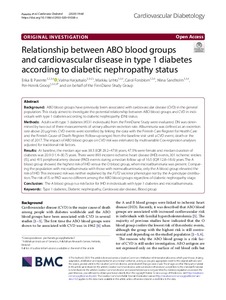Relationship between ABO blood groups and cardiovascular disease in type 1 diabetes according to diabetic nephropathy status
Erika B. Parente; Valma Harjutsalo; Markku Lehto; Carol Forsblom; Niina Sandholm; Per-Henrik Groop; and on behalf of the FinnDiane Study Group
https://urn.fi/URN:NBN:fi-fe2021042826575
Tiivistelmä
Background: ABO blood groups have previously been associated with cardiovascular disease (CVD) in the general population. This study aimed to investigate the potential relationship between ABO blood groups and CVD in individuals with type 1 diabetes according to diabetic nephropathy (DN) status.
Methods: Adults with type 1 diabetes (4531 individuals) from the FinnDiane Study were evaluated. DN was determined by two out of three measurements of urinary albumin excretion rate. Albuminuria was defined as an excretion rate above 20 µg/min. CVD events were identified by linking the data with the Finnish Care Register for Health Care and the Finnish Cause of Death Register. Follow-up ranged from the baseline visit until a CVD event, death or the end of 2017. The impact of ABO blood groups on CVD risk was estimated by multivariable Cox-regression analyses adjusted for traditional risk factors.
Results: At baseline, the median age was 38.5 (IQR 29.2-47.9) years, 47.5% were female and median duration of diabetes was 20.9 (11.4-30.7) years. There were 893 incident ischemic heart disease (IHD) events, 301 ischemic strokes (IS), and 415 peripheral artery disease (PAD) events during a median follow up of 16.5 (IQR 12.8-18.6) years. The A blood group showed the highest risk of IHD versus the O blood group, when microalbuminuria was present. Comparing the population with microalbuminuria with those with normoalbuminuria, only the A blood group elevated the risk of IHD. This increased risk was neither explained by the FUT2 secretor phenotype nor by the A-genotype distribution. The risk of IS or PAD was no different among the ABO blood groups regardless of diabetic nephropathy stage.
Conclusion: The A blood group is a risk factor for IHD in individuals with type 1 diabetes and microalbuminuria.
Kokoelmat
- Rinnakkaistallenteet [27094]
